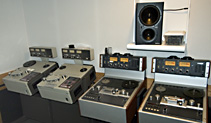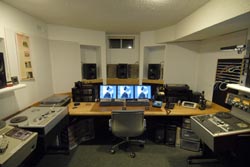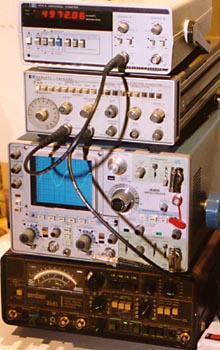Richard L. Hess
Return to home page
|
||
| M A N U A L S! |
MANUALS! I am slowly uploading some frequently requested manuals to this site. Click here for a listing Enjoy!. |
|
 |
My professional work has been in broadcast system and equipment design: |
|
 | I have now gone into audio tape restoration full-time and started my own record label to release some of the material I've remastered, although at this point, no future releases are contemplated. | |
 |
Test Equipment
|
|
 |
I spent some time in 2002 researching high-performance portable lighting...aka flashlights! I periodically revisit this topic, most recently in 2013.
|
|
|
I have decided it is time, once again, to rant about battery selection and how to select items based on the batteries that they use. |
||
|
I have two spectrographs posted that show music peaks above 20 kHz from 7.5 in/s tapes. Image 1 and Image 2 will open in new windows. Look especially at the peak "memory" bars in each band. There is also a spectrogram from an 88.2 ks/s digitization of a second generation copy of one of Jack Mullin's tapes from October 1947. |
||
|
We also have a 1-2-4 pixel grid that might be useful for monitor testing and other fun things. |
||
 |
From 2001-2004 I had an interest in learning more about radiation safety and in an effort to understand exposure, I took this set of measurements on a flight from Los Angeles to Chicago. It certainly shows an increase in exposure at altitude. What I found most interesting was that the exposure on this flight (approx 0.5 mrem) was half of what the EPA considered a level of concern spread over one year! I have also since learned that my Geiger-Mueller tube detector probably under-reports the cosmic ray radiation levels. Ten flights like this would equal the limit allowed at the fence of a nuclear plant for a year. One flight is approximately 1/600th of the average background radiation dose we absorb in North America. I started asking a lot of questions and learned a new word, hormesis. Perhaps small doses of poisons are good for you. Really. Don't take my word for it, but before you start worrying about small doses of radiation and the hysteria that accompanied Three Mile Island, please read, Underexposed: What if Radiation is Actually GOOD For You? by Ed Hiserodt. You can order it from Amazon. This book is aimed at a mid-level reader and those of a scientific bent may want more. However, it's a very easy read for anyone concerned about this vital subject and gets the key points across as plainly and as painlessly as possible (with the exclusion of some of the painful humour). Interesting facts: Nagasaki bomb survivors are dying at lower rates than a similar unexposed group in the general population for most age groups. This 1981 Japanese study reports that older people exposed to the bomb were about half as likely to die as those not exposed to the bomb radiation! People surrounding the Chernobyl reactor were forcibly resettled if the background radiation plus the radiation from the accident was a mere 83% of the average background radiation on the Colorado plateau in the U.S.! Go read the book. It's fascinating. Oh, and scribble down the math and look at the numbers and be surprised. Very surprised. The book is NOT just Hiserodt's opinion nor a collection of quotes from ill-informed newspaper articles (like some anti-radiation books available on the Web), but rather he quotes study upon study that support the view. He also comments that there are no sceintific studies that he can find that refute the view. Thankfully, the quotes from the technical papers are brief and relatively painless. Those interested in more details can start with the books and studies that he cites. |
|
| Any new construction or renovations
are best served by running multiple runs of Cat 6(e) cable. Use jacks
to field-terminate the cables (do not try and put plugs on). You can
use this for phones, audio, and data. With the demise of analog over-the-air
broadcasting, the need for coaxial cable has lessened, but still consider
FM and cable TV distribution to multiple rooms. You can run HDMI video reasonable distances over Cat 6 cable. I've had success with the MuxLab products. They also make passable audio distribution should you need it, but home entertainment in every room isn't a goal any more, it's all about personal entertainment and individual laptops can do wonders. |
||
|
Return to home page
You can e-mail Richard at richard@richardhess.com ©1997-2013 Richard L. Hess All Rights Reserved |
||